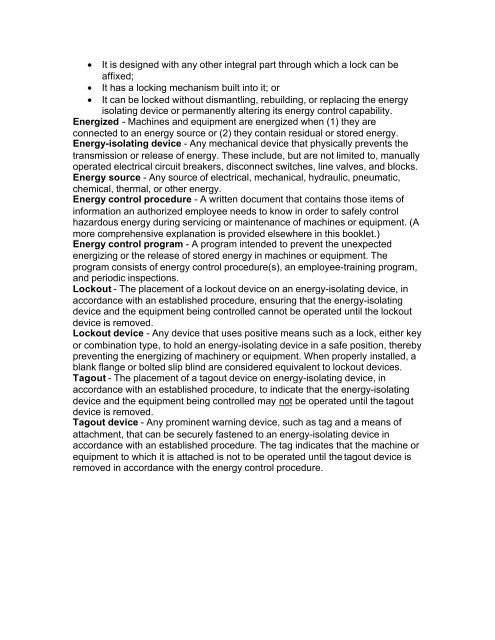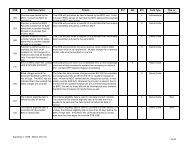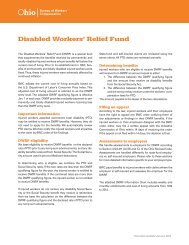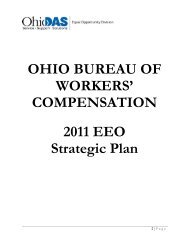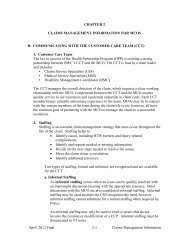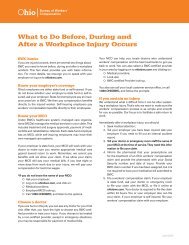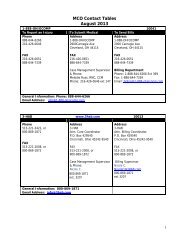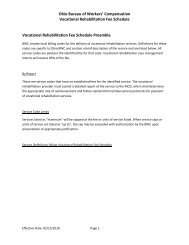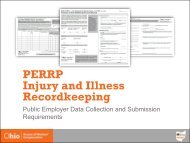Lockout / Tagout - Ohio Bureau of Workers' Compensation
Lockout / Tagout - Ohio Bureau of Workers' Compensation
Lockout / Tagout - Ohio Bureau of Workers' Compensation
You also want an ePaper? Increase the reach of your titles
YUMPU automatically turns print PDFs into web optimized ePapers that Google loves.
• It is designed with any other integral part through which a lock can be<br />
affixed;<br />
• It has a locking mechanism built into it; or<br />
• It can be locked without dismantling, rebuilding, or replacing the energy<br />
isolating device or permanently altering its energy control capability.<br />
Energized - Machines and equipment are energized when (1) they are<br />
connected to an energy source or (2) they contain residual or stored energy.<br />
Energy-isolating device - Any mechanical device that physically prevents the<br />
transmission or release <strong>of</strong> energy. These include, but are not limited to, manually<br />
operated electrical circuit breakers, disconnect switches, line valves, and blocks.<br />
Energy source - Any source <strong>of</strong> electrical, mechanical, hydraulic, pneumatic,<br />
chemical, thermal, or other energy.<br />
Energy control procedure - A written document that contains those items <strong>of</strong><br />
information an authorized employee needs to know in order to safely control<br />
hazardous energy during servicing or maintenance <strong>of</strong> machines or equipment. (A<br />
more comprehensive explanation is provided elsewhere in this booklet.)<br />
Energy control program - A program intended to prevent the unexpected<br />
energizing or the release <strong>of</strong> stored energy in machines or equipment. The<br />
program consists <strong>of</strong> energy control procedure(s), an employee-training program,<br />
and periodic inspections.<br />
<strong>Lockout</strong> - The placement <strong>of</strong> a lockout device on an energy-isolating device, in<br />
accordance with an established procedure, ensuring that the energy-isolating<br />
device and the equipment being controlled cannot be operated until the lockout<br />
device is removed.<br />
<strong>Lockout</strong> device - Any device that uses positive means such as a lock, either key<br />
or combination type, to hold an energy-isolating device in a safe position, thereby<br />
preventing the energizing <strong>of</strong> machinery or equipment. When properly installed, a<br />
blank flange or bolted slip blind are considered equivalent to lockout devices.<br />
<strong>Tagout</strong> - The placement <strong>of</strong> a tagout device on energy-isolating device, in<br />
accordance with an established procedure, to indicate that the energy-isolating<br />
device and the equipment being controlled may not be operated until the tagout<br />
device is removed.<br />
<strong>Tagout</strong> device - Any prominent warning device, such as tag and a means <strong>of</strong><br />
attachment, that can be securely fastened to an energy-isolating device in<br />
accordance with an established procedure. The tag indicates that the machine or<br />
equipment to which it is attached is not to be operated until the tagout device is<br />
removed in accordance with the energy control procedure.


